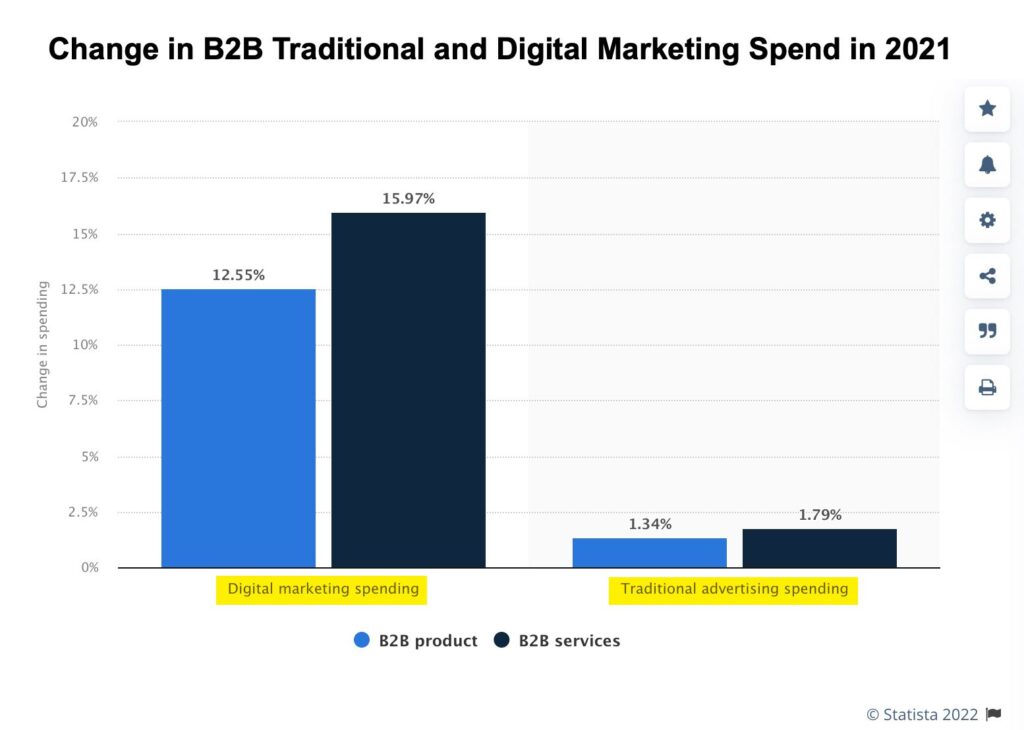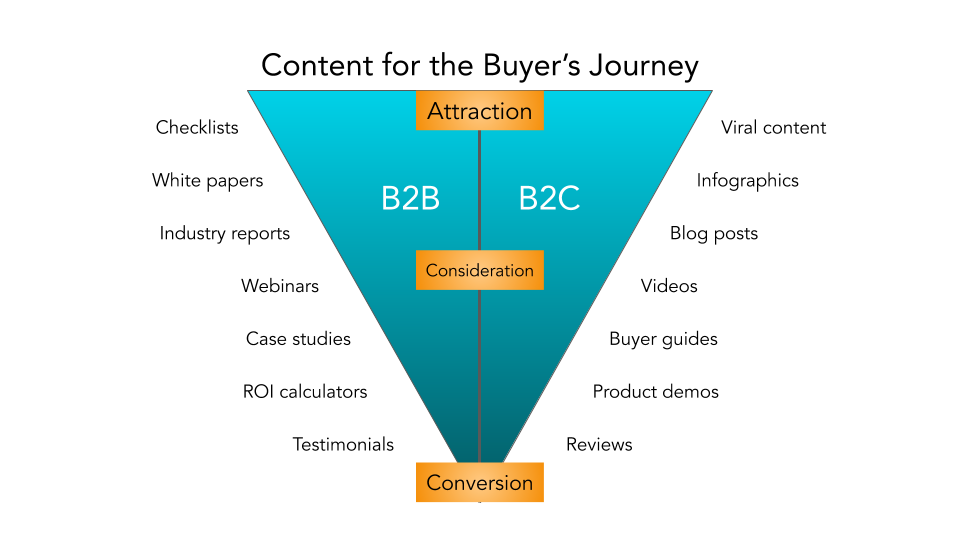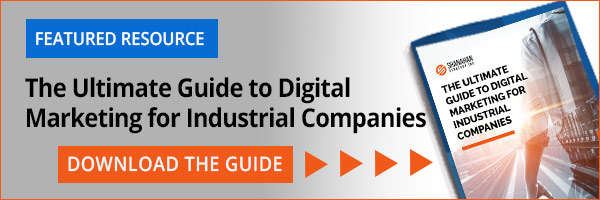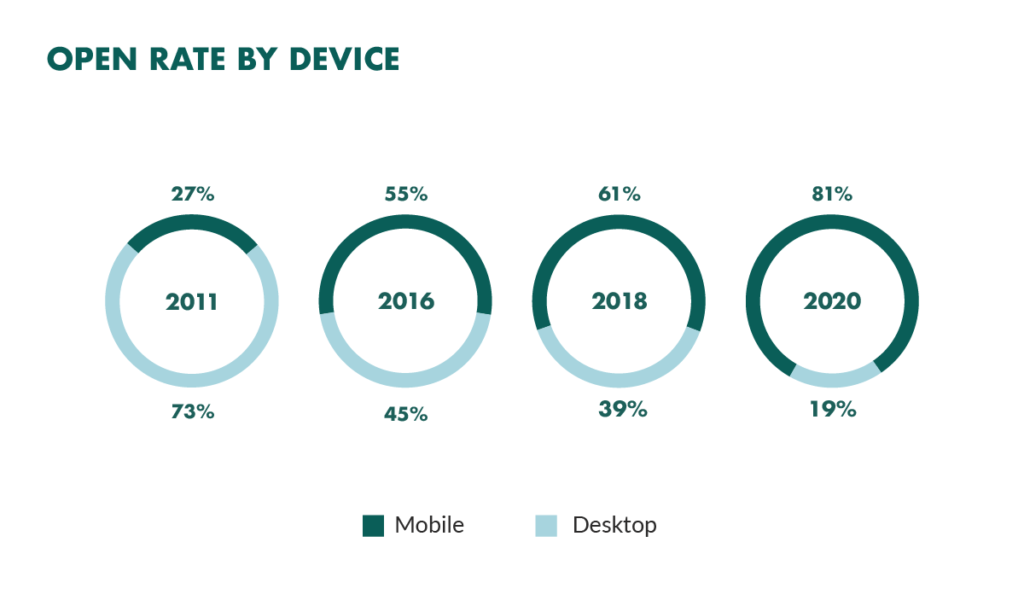Over the past 10 years, most B2B manufacturers and industrial companies have realized the growing importance of digital marketing in contrast to traditional marketing channels. Although they both still serve a valuable part in most marketing efforts, it’s clear that digital marketing is becoming more critical than ever to their overall marketing strategy and achieving positive results.
The purpose of B2B marketing is to make other businesses familiar with your brand name, the value of your product or service, and convert them into customers. The purpose of this article is a review of the top B2B digital marketing strategies that are foundational to your business.
Ready to learn the tricks and tips for B2B digital marketing? Let’s dive in!
Key Takeaways:
- Start with a clear understanding of your ideal customer(s)
- Strategy comes before tactics to avoid random acts of marketing
- Your website is typically the foundation for everything else
- Success involves a unique combination of various marketing strategies based on your business

1. Website Design and User Experience
For most businesses, your website is the foundation for all digital marketing strategies and lead generation. With that in mind, what type of first impression does your website have on visitors?
You have less than two seconds to make a good first impression on website visitors or they’re gone! Some questions to consider in this area are below.
- Is your website visually appealing for your target audience?
- Does your website speak to your audience’s needs and challenges?
- Does your website convey trust and credibility?
- Is your website fast loading and easy to navigate?
- Does your website answer common questions or leave people hanging?
- Does your website meet or exceed common performance metrics?
Nearly 95 percent of a person’s first impression relates to web design, so it’s a crucial factor in your digital marketing strategy. If your site looks like it’s straight outta the ‘90s or takes forever to load, it will likely send visitors searching for the back button.
2. SEO
Search engine optimization (SEO) is the practice of getting targeted traffic to your website from a search engine’s organic (non-paid) rankings. Common tasks associated with SEO include creating high-quality content, optimizing content around specific keywords, and building backlinks.
- High-quality content means helpful content that is valued by your target audience and optimized around keywords that offer organic ranking potential for your business.
- On-page SEO is the practice of optimizing web pages for specific keywords in order to improve search visibility and traffic to your website. It involves aligning page-specific elements like meta title tags, meta description tags, headings, content, image optimization, internal links and structured data around keywords and SEO best practices.
- Technical SEO addresses things like page speed and site speed, duplicate content, site structure, core web vitals, and site indexing. In other words, technical SEO optimization focuses on your entire website, while on-page optimization focuses on the optimization of specific pages or URLs.
SEO is a long-term strategy that helps improve your site’s organic (non-paid or free) visibility and traffic. Compared to PPC advertising or other paid adverting options, SEO is a long-term strategy that provides longer-lasting benefits, but it also takes time and patience to execute effectively.
3. PPC Advertising
PPC (pay-per-click) is a type of internet marketing that involves advertisers paying a fee each time one of their ads is clicked. Simply, you are only charged for advertising if your ad is actually clicked on. It’s essentially a method of ‘buying’ visits to your site, in addition to driving website visits organically using SEO.
Compared to SEO, PPC (pay per click) advertising is a paid advertising strategy intended to immediately improve search visibility and site traffic on search engines. Due to Google’s very high search engine market share (over 80%), Google Search Ads is one of the most popular platforms for PPC search engine advertising. Other PPC options include:
- Google Display ads
- Paid Social ads (LinkedIn, Facebook, Instagram, etc.)
- YouTube Video ads
- Google Shopping ads
- Retargeting ads
Although PPC can be very effective and extremely measurable, it’s also expensive in the long run. Most digital marketing strategies include a combination of SEO and PPC to drive the most effective results for improved website visibility, traffic, and conversions (i.e., leads, subscriptions, downloads, inquiries, etc.).
4. Content Marketing
Another crucial component of your digital marketing strategy is Content Marketing. Whereas a traditional marketing strategy interrupts a buyer’s day-to-day with promotional outbound material, a content marketing strategy adds valuable information and informs potential customers to help build trust and credibility — which is precisely what B2B buyers are looking for.
For B2B companies, content types vary by business and industry but often include the following. This content is typically found in resource libraries, blogs, landing pages, and other educational areas of the company website.
- Guides
- Tip sheets
- Checklists
- White papers
- Resource articles
- Industry reports
- Webinars
- Videos
- ROI calculators
- Case studies
- Testimonials
Lastly, content marketing supports your SEO efforts, which involves anticipating what your audience is searching for, helping them solve problems, building trust, and helping them discover your website and content … and potentially converting them to customers.

Image Source
5. Email Marketing
You might be wondering if email is still a worthwhile component of a marketing strategy. Well, it is. If you’re not using it, you’re likely missing out. Big time! In fact, email generates $42 for every $1 spent, which is an astounding 4,200% ROI, making it one of the most cost-effective tools available.
With the constant barrage of emails flooding our inboxes today, it’s more important than ever to create and send marketing emails tailored to your target audience. For B2B companies, we’ve outlined a few best practices.
- Email Lists – Building a high-quality email list is not easy and takes time. However, buying email lists is strongly discouraged for many reasons. Purchasing a list is a waste of money, damages your sender reputation, and lowers the value of any legitimate email sending you may do.
- Segmentation – Depending on your business, all subscribers are not the same. Make sure you have the ability to segment your list so you can tailor emails to their needs and interests based on their industry, type of customer, role in the company, stage of the buying cycle, and more.
- Audience Focused Content – Emails should provide value to your audience and not be self-promotional. Use email to help recipients address concerns and challenges while delivering resources and insights.
- Subject Lines – Unless your subject line is unique and enticing, most email recipients will never open the email. Your object is to engage the audience and provoke them to open and read it.
- Mobile Optimized – Today, 81% of all emails are now opened and read on mobile devices. Can you guess what your readers do when you send them an email that isn’t optimized for mobile? They delete it. In fact, 80% delete the email immediately!
- Send Frequency – As the saying goes, don’t wear out your welcome! If you’re overwhelming your subscriber’s inbox with too many emails, they’ll quickly unsubscribe. Depending on your business, sending more than 1-2 emails per week will likely annoy your subscribers.
- Test Continuously – Before and during email campaigns make sure you’re carefully proofing and testing your emails. Testing can include tests for mobile friendliness, deliverability, errors, spammy text, text/character length, formatting issues, broken links, and A/B testing.
Email marketing is a tried and true method of reaching both individual consumers and business customers. Did you know that 93% of B2B marketers use email? Are you one of them? You should be. Emails lead to engagement which turns subscribers into leads … and then customers.
6. Social Media Marketing
Although many traditional B2B industrial companies don’t see a fit for social media marketing, that’s not the case for companies like Caterpillar, Grainger, Supply House, John Deere, Kenworth, Manitowoc Cranes, Cummins, Boeing, Mammoet, Damen Shipyards, and many more.
Just like a good B2C strategy, every B2B social media plan should answer the following two questions:
- What are the company’s business objectives?
- How will B2B social media marketing help achieve our objectives?
Business objectives for B2B marketers should likely focus on longer-term goals than those for B2C social media campaigns. The top 3 overall social media goals for leading B2B marketers are:
- To improve brand awareness
- To build credibility and trust
- To inform and educate target audiences
As expected, generating sales from social media comes lower down the list for B2B companies. However, all of those top three goals contribute to social media B2B lead generation. So it’s no surprise that most successful B2B marketers also focus on using content marketing to nurture followers, subscribers, audiences, and leads.
Some examples of best practices for social media marketing include the following.
- Build your strategy around your business objectives
- Set and revisit SMART goals (Specific, Measurable, Attainable, Relevant, Time-Bound)
- Focus on social platforms where your target audience is active
- Don’t try to be all things on all social platforms … choose 1-2 platforms to get started
- Monitor your competitors to gain insights
- Share original and curated content
- Feature people (employees, customers, and suppliers)
- Experiment with different content types and posting times
- Encourage employees to share news and engaging content to their social networks
- Engage in the conversation and offer support
Success on social media takes planning, resources, and time. It may not be your primary source for lead generation, but it can definitely play an important role in your digital marketing strategy.
7. Reputation Management Marketing
Depending on your business, reputation management can have a definite impact on your business. Reputation management is the effort to influence what and how people think of your brand. Over 85% of buyers will reverse a purchase decision if there are negative reputation issues for a brand.
Good reputation management can easily help a business to gain trust and generate more leads. Hence, positive reviews can lead potential customers to trust your business even more. A good reputation means that the business is more credible than its competitors. Conversely, a bad reputation for a business can result in low trustworthiness and reduced interest in your brand, products, and services.
Reputation management is the process of monitoring how consumers perceive your business and taking strategic action when necessary to improve your brand’s image. Nowadays, reputation management is centered around monitoring and protecting your brand’s online reputation in reviews, social media, and on Google in order to attract and retain customers.
8. Marketing Analytics
Unlike most traditional marketing channels, the beauty of digital marketing is your ability to get almost instant performance results. It’s strongly recommended to set goals and measure results for any strategy and its underlying tactics. Marketing analytics help you identify high-performing results for acceleration and low-performing results for changes and possible elimination. Ask yourself, if I can’t measure and easily track results, why are we investing in it?
Boost Lead Generation with Digitial Marketing for Manufacturers
If you’re looking to engage with your audience and generate more leads, digital marketing offers a mix of strategies to help build awareness and convert contacts into long-term customers. While many manufacturers are stuck using aged marketing strategies, digital marketing allows you to cast a wider net, improve efficiencies, and help boost your ROI.
Ready to accelerate your digital marketing strategy? Get started with Shanahan Strategy Inc.


